Bright lemon and a soft crumb make this Low FODMAP Lemon Cake feel citrusy and light. Serve it with a few raspberries for extra colour and natural freshness.
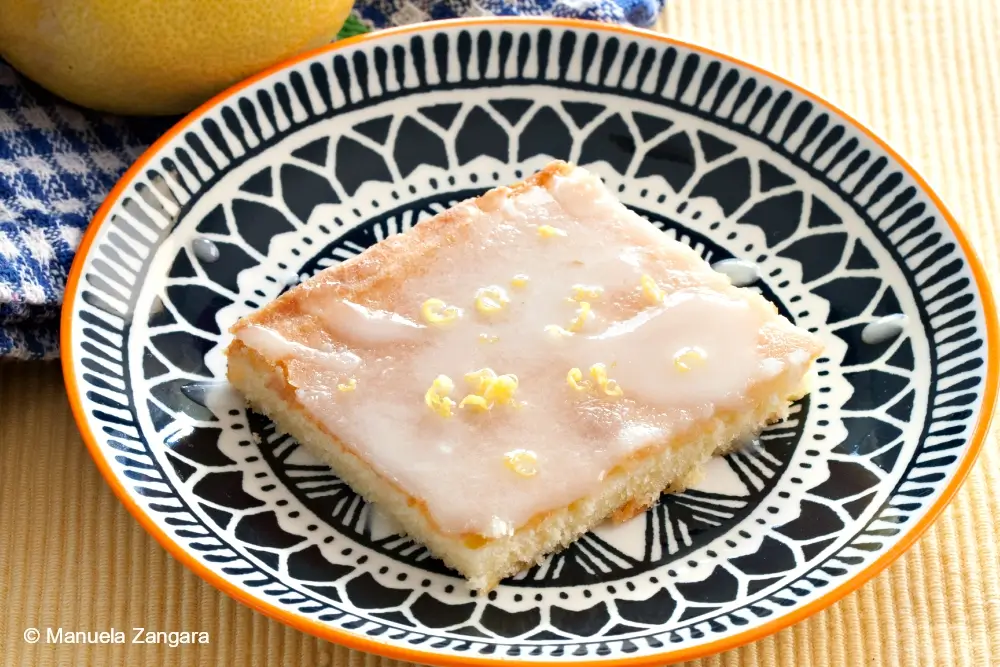
Soft and lemony, this Low FODMAP Lemon Cake comes together with simple ingredients and bakes into a light traybake with a smooth glaze on top.
It’s the kind of cake I make when I want something homemade without spending much time in the kitchen, especially on days when a small slice of something citrusy feels comforting.
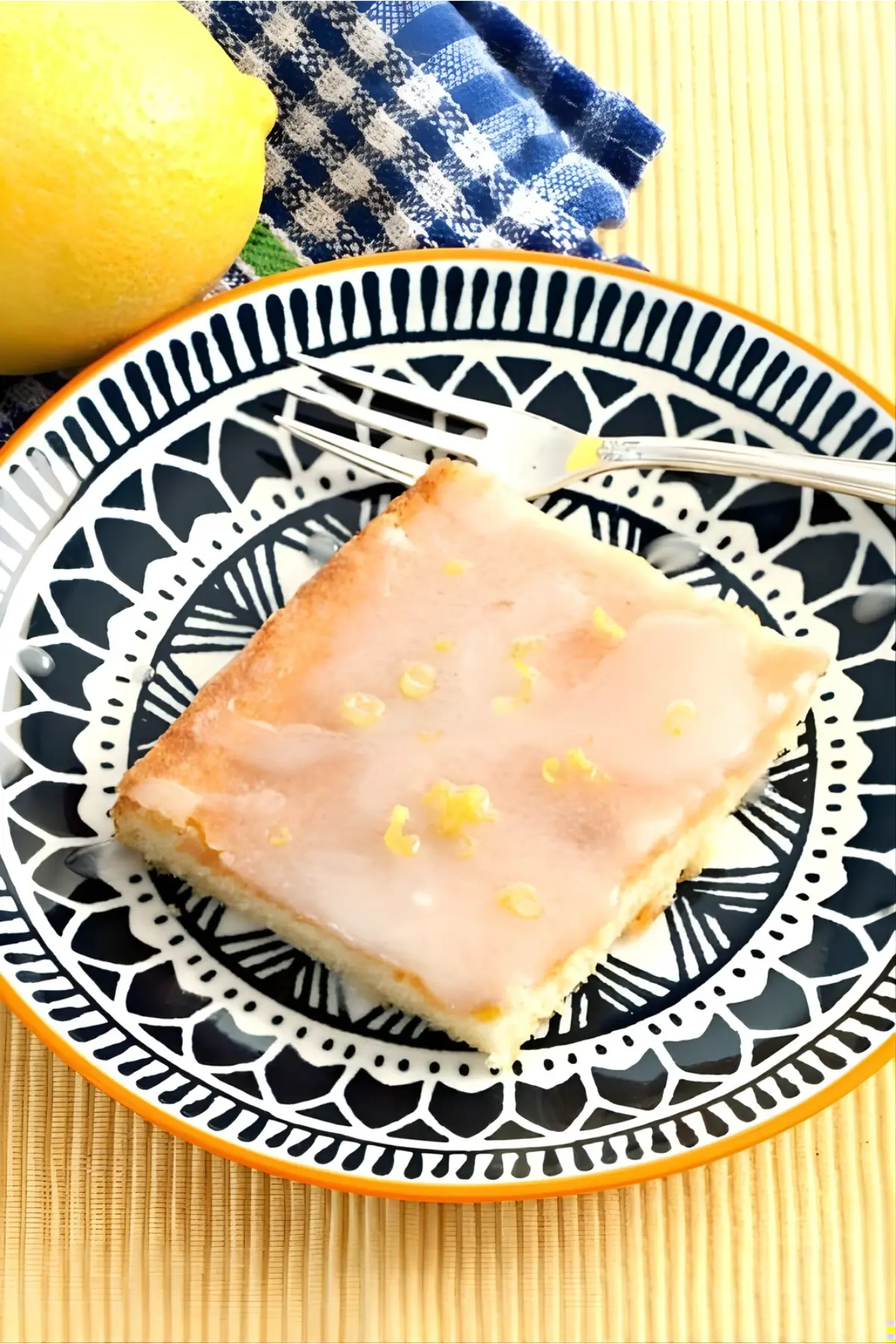
After my gallbladder surgery, my stomach never quite went back to normal. Foods I’d eaten for years suddenly made me feel uncomfortable, and it took time to work out why.
I eventually learned I was lactose intolerant, and later, IBS explained the rest. Adjusting how I cooked became part of looking after myself, and low FODMAP recipes made that shift much easier.
Manu’s Menu has always been the place where I share the food I actually cook at home, so you’ll start seeing more low FODMAP options as I add them to my routine.
Even if you’re not following this way of eating, this lemon cake works for many occasions and keeps well for a couple of days, making it a simple and reliable bake for everyday cooking.
What is FODMAP?
FODMAP is a term for certain carbohydrates that can be hard to digest if you have IBS or a sensitive stomach. These carbs ferment quickly in the gut and may cause bloating, cramps, or general discomfort.
A Low FODMAP diet keeps these foods low for a short period to help settle the gut and figure out which ingredients trigger symptoms.
Low FODMAP recipes focus on gentler ingredients such as gluten-free flours, lactose-free dairy, berries, citrus, zucchini, carrots, spinach, chicken, fish, and eggs.
With a few simple swaps, you can make everyday dishes that feel easier to digest while still tasting familiar and satisfying.
Why We Love This Lemon Cake
- Soft texture that stays pleasant even after a day or two, so you don’t need to rush to finish it.
- Works well when you need a quick dessert or something to have on the counter for guests.
- Dairy-free and gluten-free but still tastes like a classic lemon cake, so no one feels they’re missing out.
Key Ingredients for Low Fodmap Lemon Cake
Gluten Free and Low FODMAP Friendly Self-Raising Flour
Gives structure and height while keeping the crumb soft. This type of flour blends well with dairy-free spreads and creates an even texture without turning dry.
Granulated Sugar
Adds sweetness and draws moisture into the mixture. It also helps the top of the cake develop a light golden colour in the oven.
Dairy-Free Spread
Adds moisture and helps the batter come together smoothly. It keeps the cake tender and allows the lemon flavour to stay bright without creating a dense crumb.
Lemon Juice and Lemon Extract
Bring a bright citrus flavour. Lemon juice gives a gentle zing, and the extract adds a stronger citrus note that comes through in each slice.
Find the complete list with measurements in the recipe card below.
How to Make Low FODMAP Lemon Cake
For the Lemon Cake
Step 1: In a medium-sized bowl, beat the gluten-free self-raising flour, sugar, salt, and softened dairy-free spread (olive oil spread or butter) until the mixture turns doughy.
Step 2: In a separate, smaller bowl, whisk the lemon extract, lemon juice, and eggs until smoothly combined.
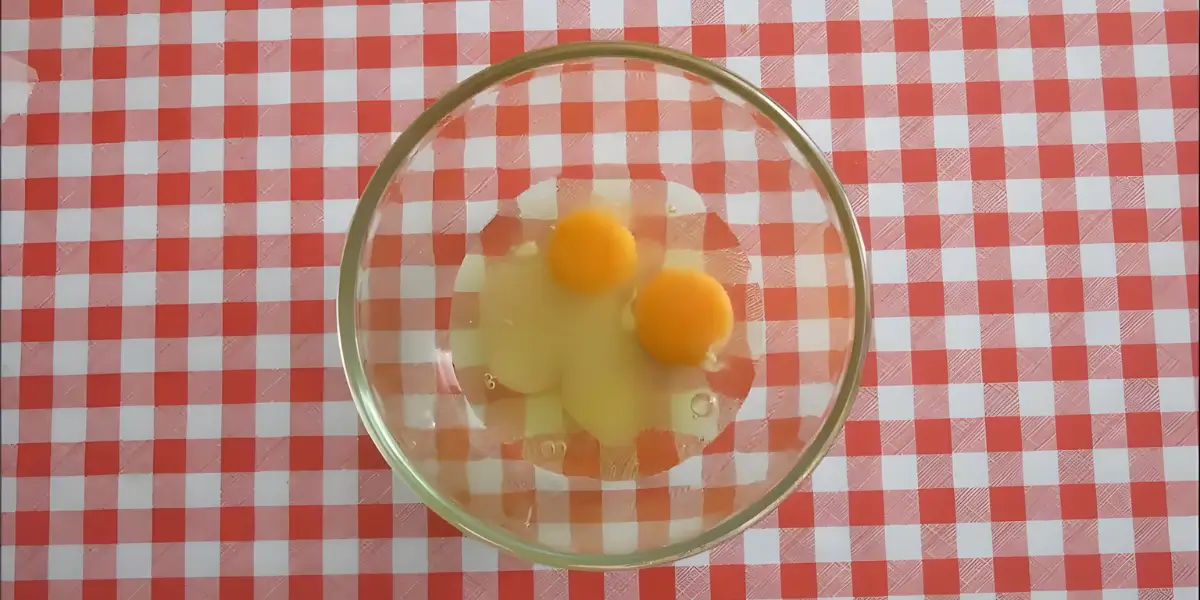
Step 3: Pour the egg mixture into the dough and beat until the batter becomes smooth.
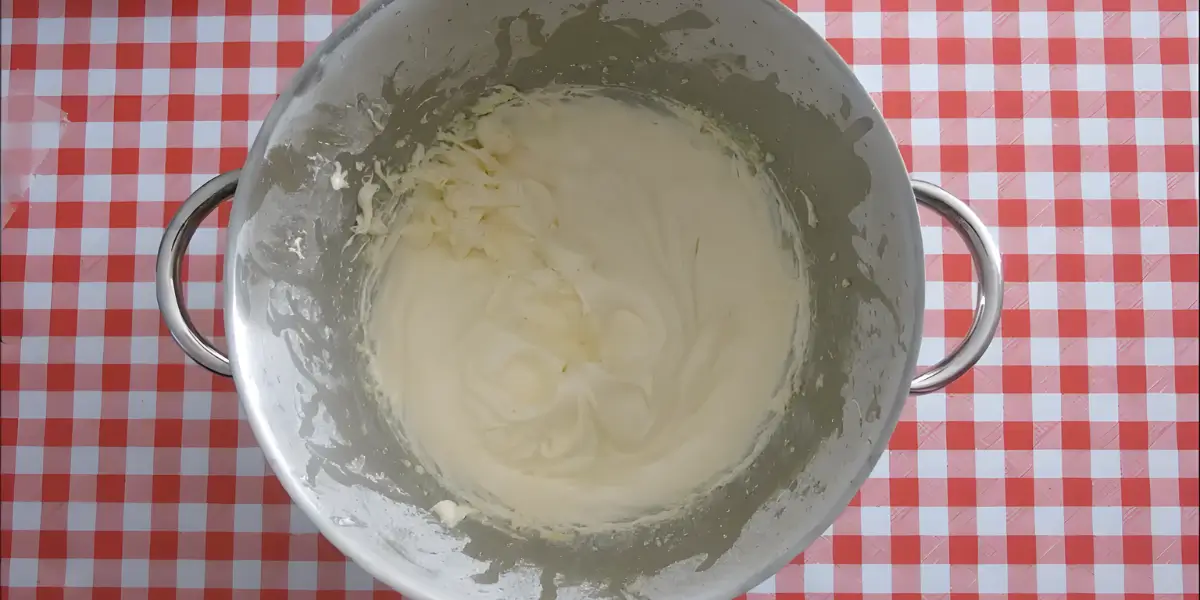
Step 4: Transfer the batter to a greased 20×30 cm (8×12 inches) baking tin and bake at 180°C – 355°F for 20 to 25 minutes, until the top is golden brown and the cake feels springy.
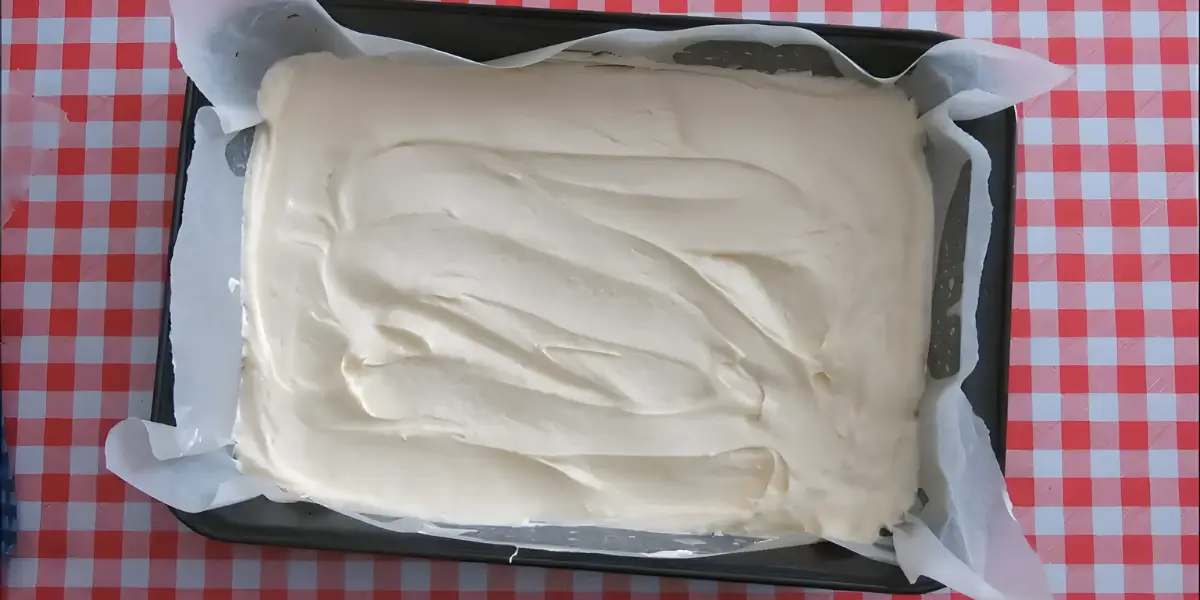
Step 5: Let the cake cool completely before icing.
For the Glaze
Step 1: Mix the icing sugar with the lemon juice, adding the juice gradually as you may need less.

Step 2: Once the glaze is smooth, pour it over the cake and spread it evenly with a spatula.
Step 3: Sprinkle lemon zest on top. Leave the cake to set before cutting into 12 squares.
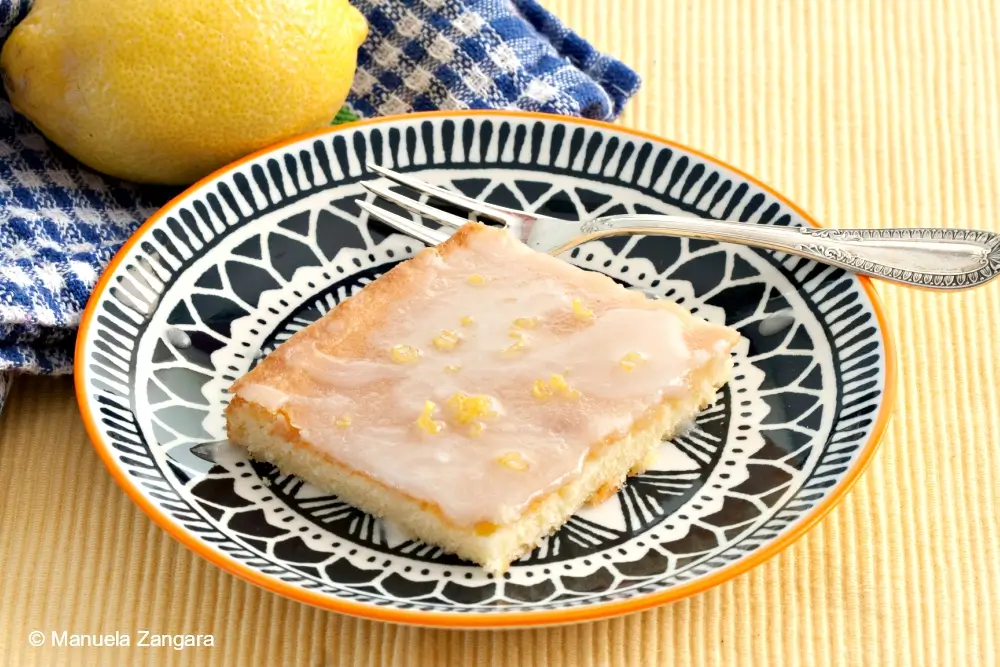
Frequently Asked Questions
You can, but the cake will no longer be low FODMAP. Regular self-raising flour gives a similar rise and crumb, so you do not need to adjust any other ingredient.
A small reduction is fine, though sugar affects moisture and texture in this type of cake. Taking out too much makes the crumb feel dry or firm. If you prefer a cake that is less sweet, start by reducing only 1–2 tablespoons and check the texture the next time you bake it.
Yes, butter works well if you do not need a low FODMAP or dairy-free version. It gives the cake a slightly richer taste and a softer crumb.
Yes, small amounts of blueberries or raspberries work within low FODMAP portions. Fold gently at the end so the fruit stays whole and spreads evenly through the cake.
Extra Help From the Kitchen
Avoid Overmixing – Once the batter turns smooth, stop mixing. Overworking gluten-free flour can make the cake feel dense, so keeping the mixing brief protects the soft texture.
Test Glaze Thickness First – Place a small drop of glaze on a plate to see how it settles. If it spreads too quickly, add more icing sugar until it flows slowly enough to coat the top without running off.
Slice With a Warm Knife – Warm the knife under hot water and dry it before cutting. This helps glide through the glaze and gives clean slices without dragging the top layer.
Let the Cake Cool Fully – Cooling allows the crumb to settle and makes the surface stable for the glaze. Pouring glaze too early leads to absorption instead of a smooth top.
Line the Tin for Easy Removal – A sheet of baking paper under the batter helps lift the cake out without cracking the edges. This makes slicing cleaner and serving simpler.
Variations and Twists
Use Almond Flour Instead of Some Self-Raising Flour – Replace up to ¼ of the gluten-free self-raising flour with almond flour for a light nutty note that keeps the recipe Low FODMAP in moderate portions.
Use a Light Dairy-Free Yoghurt Addition – Add ½ cup lactose-free or coconut yoghurt in place of part of the spread to create a moister crumb with a gentle tang.
Add Berries – Mix a small handful of fresh blueberries or raspberries into the batter. Keep portions Low FODMAP and fold gently so the fruit stays evenly distributed.
Use Meyer Lemons for Milder Flavour – Swap standard lemons for Meyer lemons in the same quantities. They offer a softer citrus profile and work well with the glaze.
Storage and Shelf Life
Store the cake in an airtight container at room temperature for 2–3 days. Keep it away from direct sunlight to maintain the texture of the glaze. Freeze the unglazed cake for up to 1 month, wrapped in baking paper and then foil.
Thaw in the fridge or at room temperature before adding the glaze. Reheat slices briefly in the microwave only if you want them warmed through before serving.
Low FODMAP Ideas for Your Next Meal

Low FODMAP Lemon Cake Recipe
Bright lemon and a soft crumb make this Low FODMAP Lemon Cake feel citrusy and light. Serve it with a few raspberries for extra colour and natural freshness.
Ingredients
Lemon Cake
- 105 g – ¾ cup gluten free and low FODMAP friendly self-raising flour
- 157 g – ¾ cup granulated sugar
- ¼ tsp salt
- 100 g – ½ cup dairy-free spread – softened
- 2 large eggs
- 2 tbsp lemon juice
- 1 tsp lemon extract
Lemon Glaze
- 3 ½ tbsp lemon juice
- 130 g – 1 cup icing sugar
- lemon zest
Instructions
For the Lemon Cake
-
In a medium-sized bowl, beat the gluten-free self-raising flour, sugar, salt, and softened dairy-free spread (olive oil spread or butter) until the mixture turns doughy.
-
In a separate, smaller bowl, whisk the lemon extract, lemon juice, and eggs until smoothly combined.
-
Pour the egg mixture into the dough and beat until the batter becomes smooth.
-
Transfer the batter to a greased 20×30 cm (8×12 inches) baking tin and bake at 180°C – 355°F for 20 to 25 minutes, until the top is golden brown and the cake feels springy.
-
Let the cake cool completely before icing.
For the Lemon Glaze
-
Mix the icing sugar with the lemon juice, adding the juice gradually as you may need less.
-
Once the glaze is smooth, pour it over the cake and spread it evenly with a spatula.
-
Sprinkle lemon zest on top. Leave the cake to set before cutting into 12 squares.







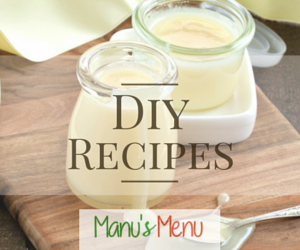
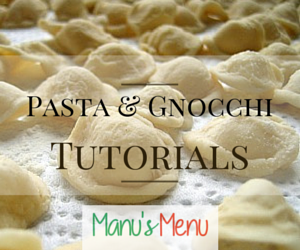

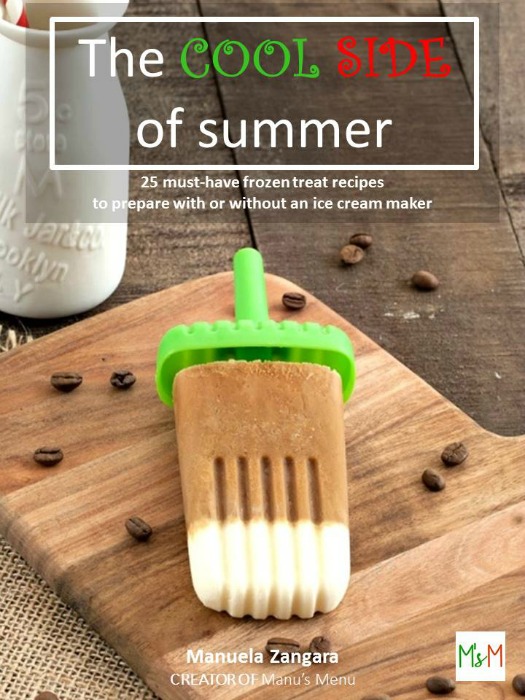








Leave a Reply